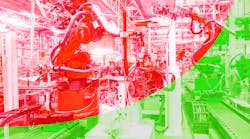Manufacturing continued its rebound from an April course correction, posting its fourth straight month of growth according to the Institute for Supply Management’s monthly PMI Index.
The index rose 1.8 percentage points in August to 56.0%, the third month in a row the index was above the 50% threshold for growth in the sector, and 14.5 percentage points above the 41.5% reading in April that ended a 12-year streak of economic growth.
While the effects of the COVID-19 pandemic have not yet disappeared, there is some stability in supply chains and strong growth in certain sectors.
“After the coronavirus brought manufacturing activity to historic lows, the sector continued its recovery in August, the first full month of operations after supply chains restarted and adjustments were made for employees to return to work,” said Timothy Fiore, chairman of the Institute for Supply Management Manufacturing Business Survey Committee. “Members reported that their companies and suppliers operated in reconfigured factories, with limited labor application due to safety restrictions. Panel sentiment was generally optimistic (1.4 positive comments for every cautious comment), though to a lesser degree compared to July.”
New orders continued to increase at a brisk pace, as did the production index. There are still a number of sectors struggling to keep pace with internal production levels, but other sectors are clearly on the rebound.
“Demand and consumption continued to drive expansion growth,” Fiore added. “Among the six biggest manufacturing industries, Food, Beverage & Tobacco Products remains the best-performing sector, with Chemical Products; Computer & Electronic Products; and Fabricated Metal Products growing strongly. Transportation Equipment also expanded, but at a low rate. Petroleum & Coal Products sunk into contraction territory. Impacted by the current economic environment, many panelists’ companies are holding off on capital investments for the rest of 2020.”
Three sectors in particular—commercial aerospace, office furniture, and related suppliers and the oil and gas markets continue to be impacted by low demand. “These companies represent approximately 20% of manufacturing output. This situation will likely continue at least through the end of the year,” said Fiore.
Comments from committee members reflected the disparity among the various manufacturing sectors:
- “Watching COVID-19 situations in Mexico, Brazil, Philippines [and] Hong Kong. High rates of COVID-19 surging. Currently, lines of supply no longer impacted by COVID-19 related events.” (Computer & Electronic Products)
- “Business is very good. Production cannot keep up with demand. Some upstream supply chains are starting to have issues with raw material and/or transportation availability.” (Chemical Products)
- “Airline industry continues to be under great pressure.” (Transportation Equipment)
- “Current sales to domestic markets are substantially stronger than forecasted. We expected a recession, but it did not turn out that way. Retail and trade customer markets are very strong and driving shortages in raw material suppliers, increasing supplier orders.” (Fabricated Metal Products)
- “Homebuilder business continues to be robust, with month-over-month gains continuing since May. Business remains favorable and will only be held back by supply issues across the entire industry.” (Wood Products)
- “We are seeing solid month-over-month order improvement in all manufacturing sectors such as electrical, auto and industrial goods. Looking to add a few factory operators.” (Plastics & Rubber Products)
- “Rolling production forecasts are increasing each week compared to prior forecast.” (Primary Metals)
- “[Production ramp-up] has been a struggle. We have started and stopped lines numerous times at all 18 of our manufacturing plants due to COVID-19 issues. Surprisingly, our direct suppliers have done an excellent job on shipping ingredients and packaging on time.” (Food, Beverage & Tobacco Products)
- “Strong demand from existing and new customers for our products, stable-to-decreasing input costs for our operations, and record numbers of new business opportunities from prospective customers’ reshoring measures. All trends continuing from the first quarter of fiscal year 2017.” (Electrical Equipment, Appliances & Components)
- “Capital equipment new orders have slowed again. Quoting is active. Many customers waiting for the fourth quarter to make any commitments.” (Machinery)
- “We are starting to see parts of our business rebound in August, while other parts remained weak. Some of our export business has come back for the first time since the start of COVID-19; however, domestic portfolios remain mixed.” (Paper Products)

